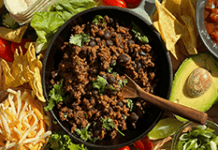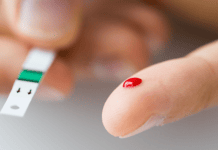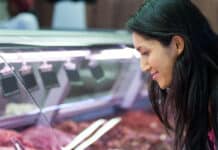 By now you’ve likely heard about the most recent pro-vegan Netflix documentary ‘You Are What You Eat: A Twin Experiment’. It went live late December, during a highly influential time when motivations to make health or diet related new years’ resolutions are at their peak. How convenient.
By now you’ve likely heard about the most recent pro-vegan Netflix documentary ‘You Are What You Eat: A Twin Experiment’. It went live late December, during a highly influential time when motivations to make health or diet related new years’ resolutions are at their peak. How convenient.
Before I delve into the review of the series and study tied to it, I want to give you some perspective on me and my background. I am a Registered Dietitian and CEO of a private practice in Saskatoon, SK. I work with all kinds of clients seeking support with their chronic conditions, food relationship, and family meal planning. I support my clients to meet their nutrition needs and improve their overall wellbeing, no matter their dietary pattern. This may include veganism, so I’m well versed in vegan eating patterns and nutrients of concern that must be supplemented or attained from fortified foods. Ultimately, my nutrition knowledge is built on science-based evidence and practice-based learnings.
First I’m going to review the study tied to the Netflix documentary, then I’ll review some of the claims made throughout the documentary. Let’s dig in.
The Study
The study is a randomized clinical trial published in JAMA in November 2023 titled, ‘Cardiometabolic effects of omnivorous vs vegan diets in identical twins’. Participants included 22, healthy adult, identical twin pairs who were randomized into either a “healthy” vegan diet or “healthy” omnivorous diet for 8 weeks (with one set of twins dropping out). Diet-specific meals were provided for the first 4 weeks, then from weeks 5 to 8 participants prepared their own diet-appropriate meals and snacks with the help of counseling from a registered dietitian. The diets emphasized vegetables, fruits, and whole grains while limiting added sugars and refined grains.
The results after 8 weeks included the following:
- A sizeable reduction in LDL or “bad” cholesterol in the vegan group which was seen as early as 4 weeks. There was no change to LDL cholesterol in the omnivorous group.
- Fasting insulin was reduced in the vegan diet group, with no significant change in the omnivorous group. Fasting glucose decreased non-significantly in both groups.
- Weight loss was observed in both diet groups, with a slightly higher weight loss observed in the vegan group.
- The vegan group saw a decrease in HDL cholesterol with triglycerides trending upward, although non-significantly. This is an undesirable change given HDL’s cardioprotective role, and risk for heart disease if triglyceride levels rise above normal limits. There was no change to HDL in the omnivorous group and triglycerides decreased, although non-significantly. Both groups maintained triglycerides within healthy ranges.
- TMAO (trimethyl-amine N-oxide) – which is correlated to artery-clogging effects, and adverse cardiometabolic risk – did not significantly differ between the two diet groups.
- The vegan diet had a lower intake of protein as a percentage of calories and lower dietary satisfaction.
Overall, the only significant outcome shown in the study was the reduction in LDL cholesterol. The authors noted that while vegan participants saw a greater reduction in LDL, “excluding all meats and/or dairy may not be necessary because research suggests that cardiovascular benefits can be achieved with modest reductions in animal foods and increases in healthy plant-based foods”. A vegan diet is not the only way to reduce LDL cholesterol.
While the vegan diet group participants lost more weight, it was interesting that the body composition reports of the 4 pairs of twins in the documentary showed muscle loss in all of the vegan diet group participants. Muscle maintenance or gain was seen in the majority of the omnivorous group participants (with exception to one person who lost muscle). The study authors also noted that the study was not designed to be isocaloric (ie. having similar caloric values between the two groups) thus, changes to LDL cannot be separated from the greater weight loss observed in vegan participants.
After reviewing the supplementary data within the study, there were a few red flags that jumped out at me. The first relates to the dietary recommendations for each group. The omnivorous group was instructed to consume 3 servings of vegetables and 2 servings of fruit every day, where the vegan group was instructed to consume 6 servings of vegetables and 3 servings of fruit – 4 extra daily servings. This is a significant difference without any explanation or rationale. When we look at various guidelines, the World Health Organization recommends an intake of at least 5 servings of fruit and vegetables per day, where the American Heart Association recommends 4-5 servings of each per day (8-10 total servings). Studies demonstrate that higher intakes of fruit and vegetables lowers risk for coronary heart disease (Joshipura et al, 2001), and higher fruit and vegetable intake is associated with reduced LDL cholesterol (DeJusse et al, 2004). The additional 4 servings of fruit and vegetables in the vegan group would have contributed to their higher fibre intake. Therefore, it’s difficult to say with confidence that this is a fair comparison between the two diet groups.
It was also interesting that intake of meat alternatives (e.g. nut butters, nuts/seeds, pulses, and possibly other plant based alternatives) decreased from baseline during the food delivery and self-provided phase among omnivorous participants. This suggests that the “healthy” omnivorous diet actually reduced the variety of plants that people might typically consume.
Finally, I couldn’t help but wonder why this wasn’t a blinded study. The diets of the participants were not blind to the researchers nor the personal trainers of those featured in the documentary. This leaves room for influence affecting study results, and can lead to evaluating and reporting bias. As I continued to tease out bias, I noticed the study was funded by Vogt Foundation – a private foundation that previously funded Game Changers, another popular pro vegan documentary. Additionally, one of the researchers, Christopher Gardner, has also received sponsorship and payment from Beyond Meat. So we can start to see a trend and potential for bias.
The Documentary
it wouldn’t be a documentary without a hero and a villain.
Being a pro-vegan documentary, there was a heavy focus on implications of animal agriculture, from environmental concerns to population health concerns and exploitation of people and animals. I found myself fact checking claims that don’t hold up in Canadian practices, for example, injecting all beef cattle with antibiotics. Then they got into the Glow Germ experiment which felt like a ridiculous attempt to scare people out of eating meat. An uncooked chicken was slathered with Glow Germ, and after the participants cooked the chicken and cleaned up the kitchen, using a black light, they visibly showed where bacteria had contaminated the kitchen. Not all bacteria is harmful (pathogenic), and the black light is going to show any bacteria on the chicken, including non-harmful bacteria. In Canada, the majority of food borne illnesses involving chicken is caused by undercooked chicken that contains salmonella or campylobacter. What about vegetables – they contain bacteria too, and pathogens existing on vegetables are recalled regularly.
My ears shot up when Dr. Michael Greger came into the picture, spewing fear-mongering statements aligning the consumption of processed meat to the risk of cancer from cigarette smoking. Dr Greger is a physician, author and plant-based advocate. At this point in the documentary, Dr. Greger states, “we are as sure that processed meat causes cancer in people that cigarette smoking and asbestos cause cancer”. This sounds so alarming, and so matter-of-fact. Yet, there is much more to the story that he fails to tell. Let me explain. In 2015, after a review of the available evidence (epidemiological evidence that is, which never proves cause and effect relationships), The International Agency for Research on Cancer (IARC) classified processed meat as carcinogenic to humans, where 50 grams of processed meat (e.g. 6 slices of bacon) eaten daily increases the risk of colorectal cancer by 18% (defined as “small increases in risk”). Even though smoking is in the same category as processed meat (ie. a Group 1 carcinogen), the risk associated with smoking is 2000% higher than that of processed meat. The IARC states that “red meat has nutritional value. Therefore, these results are important in enabling governments and international regulatory agencies to conduct risk assessments, in order to balance the risks and benefits of eating red meat and processed meat”. So in classic documentary fashion, a complex topic is falsely simplified into a single statement, leading to mis-representation of the science and consensus.
Interestingly, the documentary added additional “study” markers that weren’t included in the JAMA study: the gut microbiome, telomere length (connected to longevity) and genital blood flow while watching pornography, (which, by the way, was only discussed in 2 sets of twins and really didn’t tell us anything about the health or sexual health of the participants). They were able to cherry pick some interesting but non-significant outcomes, adding sensationalism and bias to the documentary.
As a dietitian with a focus on gut health and function I was paying close attention to the microbiome discussions. It was claimed that with without “plant based” carbohydrates (spoiler alert, all carbohydrate foods are plants), the stomach lining starts to eat itself inside out, which sounds scary. However, what research currently suggests is:
-
- that high fibre carbohydrate foods are needed for healthful mucous barrier function, inhibiting inflammatory responses, intestinal function, and microbial production;
- that ketogenic (or high fat, low fibre) diets are shown to negatively alter the gut microbiome.
This claim that the stomach lining eats itself isn’t accurate, and it really isn’t about meat or dairy consumption, rather, having enough high fibre carbohydrates in the diet.
We know that there are a number of environmental concerns worldwide, and agriculture overall, including plant derived ag, is a small contributor to greenhouse gas emissions (~ 10%, not the 30% reported in the documentary). Let’s not forget that household food waste is also a significant contributor to greenhouse gas emissions. While eating more plants – vegetables, fruit, grains and cereals, pulses, and nuts and seeds – has been shown to have less greenhouse gas intensity, the United Nations Climate Action report states that animal products remain an important source of food security, nutrition, and livelihood for a large number of populations around the world.
Bottom line, food and eating is complex, it is personal, and the health of an individual doesn’t just come down to what they eat. Netflix’s “documentary”, ‘You Are What You Eat: A Twin Experiment’ is meant to persuade and advocate for veganism, and there isn’t anything balanced about it. As for the study itself – a short timeline with a small sample size of already healthy twin pairs – it demonstrated that adding more plants, including an additional 4 servings of fruit and vegetables daily, may lower LDL cholesterol.

Written by Brooke Bulloch, RD.
Feb 2024





